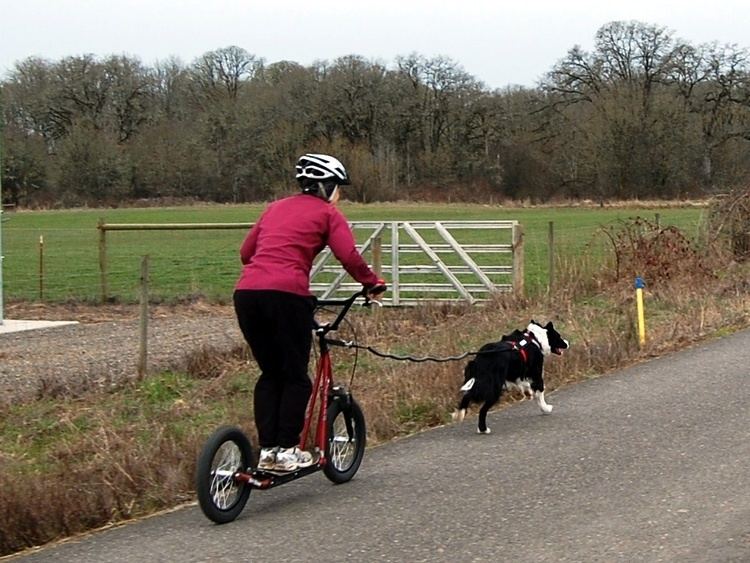 | ||
Dog scootering is an activity where one or more dogs pull a human riding an unmotorized kick scooter. It is similar to mushing, which is done in the winter, but generally with fewer dogs and with a scooter instead of a dogsled. The dogs wear the same harnesses that sled dogs wear, and are hooked to the scooter with a gangline. The gangline usually incorporates a bungee cord to smooth out the shocks of speeding up and takeoff.
Contents
Scooter
The scooter is generally unmotorized, and has mountain-bike-style tires ranging from 16" to 26". These are not razor-type mini scooters, which would be dangerous in this sport. The scooters incorporate mountain-bike-style brakes and have a large footboard to stand on and kick off from. The scooters are occasionally called kick bikes because they are not yet largely marketed for the activity of dog scootering, although Pawtrekkers have a 'brushbow' attachment on the front to protect the dogs from the wheel and to provide an ideal pulling position for connecting the ganglines. Some of the other scooters like Diggler's Alpha Dawg also incorporate front shocks similar to mountain bikes to absorb bumps better and has a recoiling tug line that works to managing the gang line efficiently. the scooter is commonly used in (dry land ) or dirt based racing through forests , A single dog or two dogs are the maximum on the scooter in Australian sled dog racing, three and more will use a rig (gig) typically 3 or four wheels. With limited snow in Australia, dry land racing is popular in all states of Australia, as of 2016, only Northern Territory does not have a registered competition. At present there are 4 snow races in Victoria, Australia, using typical snow sleds, and skijoring . An alternative is to use a bicycle instead of a scooter. This is seen as a more dangerous alternative, as it is more difficult to dismount a bicycle in an emergency. This alternative activity of harnessing dogs to a bicycle is known as bikejoring.
Benefits
Scootering provides exercise both for the dog and the rider. The dog gets exercise pulling the scooter but people have to help push, especially up hills. Dogs that exercise regularly tend to be better behaved, as a lot of bad behaviour is due to boredom and lack of exercise.
Most dogs take to this sport readily. They get to run as fast as they can and get to see and visit new places. As dog scooterers become more experienced, they tend to take their dog(s) and scooter(s) with them to new trails. This can lead to a stronger bond between people and their dogs.
Activities
Dog scooterers get together for fun runs, where a number of dog scooterers run their dogs and scooters on the same trails. Fun runs may be just a morning run, or can be a weekend-long activity with multiple runs scheduled. This is still a maturing activity, but there are a few formal dog races that include scooter events.
In December 2005, dog scooterers are putting on the first Dog Powered Sports relay, Dogs Across America, where participants from around the country will choose one of the trails in their state and ride it in relay style to cover the entire length. Dog scootering is now growing in the UK, with scootering classes having been introduced to the major dryland sled dog race associations calendars.
